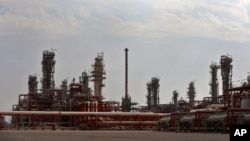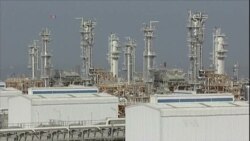Iran sits on what are thought to be the world’s largest gas reserves, yet can barely supply its own domestic demand.
Since the United Nations-backed deal over Tehran’s nuclear program spurred the lifting of international sanctions, the country has strived to attract foreign investment in developing oil fields and upgrading its aging infrastructure.
The Ministry of Petroleum helped to convene the CWC Iran Gas Conference this week in Frankfurt, Germany, to bring together government figures and private investors.
Watch: Energy Giants Say Iran Needs $100 Billion for Gas Upgrade
Industry experts: $100 billion needed
Industry estimates suggest Iran needs to invest $100 billion in order to fully exploit the reserves. The nuclear agreement removed some sanctions on Iran, but mainly in Europe. It remains extremely difficult for American companies to do business, according to Reiner Jahn, vice president of the German-Iranian Chamber of Commerce and expert on financing deals with Iran.
“Unless it’s licensed by OFAC, the U.S. sanctions authority, there is no way for an American to negotiate any transaction with an Iranian,” he said.
So Iran is looking elsewhere.
Indian demand for gas is forecast to grow rapidly, and Tehran sees it as a key market. The private consortium South Asia Gas Enterprise, or SAGE, has advanced plans for the world’s deepest underwater pipeline connecting the two countries.
“Our reconnaissance survey was performed between Oman and India. Unfortunately at that time the leg that went to Iran couldn’t be surveyed because of sanctions. SAGE is expecting to perform the remaining leg of the survey to Iran this year,” project director Ian Nash told delegates at the conference.
The 1,300-kilometer, $5 billion pipeline would lie on the seabed, more than 2,500 meters below the ocean’s surface. The viability of such investments depends on the price of gas, currently difficult to predict, says Vincent Groote of Dutch engineering firm Twister Supersonic Gas Solutions.
An OPEC for natural gas
“You get [the price] floating up and down, which is not what investors would like. So I can imagine that as a natural development, similarly as OPEC for oil, in the long future we could think about a ‘GPEC’ — let’s say a Gas-Producing-Exporting Country’ type of infrastructure.”
Iran likely would wield considerable power in such a cartel, though there are clouds on the horizon.
U.S. President Donald Trump has repeatedly criticized the nuclear deal, and he has imposed new sanctions on Iran following a recent missile test. History shows that the United States could still intervene to disrupt foreign investment, says Jahn.
“The U.S. invented secondary sanctions, where they sanction European companies that acted in complete accordance with EU law, but not in accordance with U.S. law. Therefore. I think they have an impact in our market,” he said.
The French bank BNP Paribas was fined $8.9 billion by U.S. authorities in 2014 for breaking such sanctions.
The nuclear deal may have lifted some restrictions, but analysts say Trump has introduced new uncertainty just as foreign investment in Iran starts to build.







